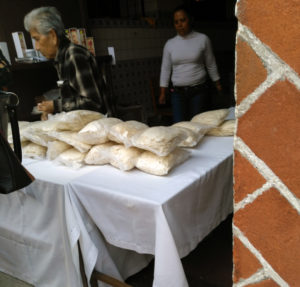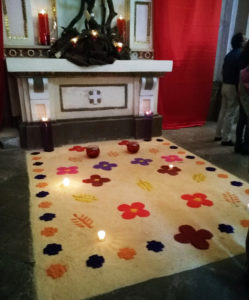On a Holy Thursday night in Puebla, Mexico, about 80 miles southeast of Mexico City, my two teen sons and I wandered the streets, along with everyone else in town it seemed, moving in and out of wide-open church doors. I had mainly brought us here for Good Friday, for the processions, maybe for a dramatic Way of the Cross, but it was Holy Thursday that ended up making the impact — converting me, in a way.
The day’s Mass — the Mass of the Lord’s Supper — is all about Jesus, his disciples, the Last Supper and the Garden of Gethsemane, the place of prayer, sweat, blood, betrayal and, for the rarely helpful disciples, a nap.
The priest or deacon doesn’t intone, the Mass is ended in this service, because … it doesn’t actually end. This is the first of three parts — together called the Triduum — that flow one into the other, bringing us into the events of those days: The Last Supper, the agony in Gethsemane, the crucifixion, and the Resurrection.
So, at the end (but not really) of Holy Thursday, the altar is stripped, the lights are dimmed, we walk along with Jesus in the Eucharist, we chant “Pange, lingua, gloriósi” and then Jesus in the Eucharist is placed on an Altar of Repose: rest.
“Could you not stay awake with me for one hour?” Jesus asked his friends.
“Yes, we’ll stay awake,” we, his purported friends, say. So we remain in those churches and we pray awhile. We come and go, we take turns. We wait with him. We watch. It’s a vigil.
From church to church
In places where there were a lot of Catholics living near one another, worshiping in churches a few blocks apart, the tradition developed of traveling from church to church, visiting different altars of repose throughout the night. Seven was the traditional number since seven is the traditional best number in general: it’s a number about completeness: And on the seventh day, he rested.
People tried this back home in Alabama (I among them) but it was a challenge. You’d drive all over town and show up at churches where you thought you might pray only to find them locked up for the night.
Not so in Puebla. This visitation of the seven churches (or more, probably) was most definitely “A Thing.” In fact, it was not just a thing. It was a party.

A street vendor sales corn husks for tamales outside a church in Puebla on Holy Thursday. (Courtesy of Amy Welborn)
All the church doors were wide open, the crowds streamed in, prayed, and then streamed back out. At the door of every church, women were ready, selling elotes, tacos, enchiladas, empanadas, and paletas. Each scene was bustling, cheerful, social.
I was surprised. But more than that, challenged.
This challenge had begun earlier in the day when I awoke and looked from the hotel window down into the plaza below. Vendors were setting up all over the place, carts full of drinks, snacks, toys, and balloons.
“Well,” I thought. “I guess Lent really is over.”
Growing up Catholic
You might not be surprised to learn that I was a spiritually insufferable child and young person, judgmental and strict with everyone except myself. As an adolescent, I decisively (and probably meanly) positioned myself in opposition to my mother in every possible way.
My mother, for example, kept the Friday abstinence long after it was dropped by the Church, but for whom the whole thing was about going with fish and seafood more than going without meat. She’d go to great lengths to put fried shrimp or salmon cakes or some other seafood in front of us on Friday. She’d insist on going out to eat if we had no fish in the house. I thought this was ridiculous (and maybe it was) and also determined that fish was the same as meat and scorned her for not simply settling for beans or grilled cheese.
Where, I would internally sneer, was the sacrifice in a shrimp dinner at the fancy (at least for 1970s Knoxville, Tennessee) restaurant? We were both purists in our own way, I suppose — which was the way most of us ended up doing Catholic things in those post-Vatican II years. We could do things our own way, it seemed, since the Church had evidently decided we’d do it all just fine without any help.
That thickness of Catholic life that had produced all the riot of traditional practices, that had organically grown in the context of community and intimacy of tradition, well-balanced between feasting and fasting — that was just gone.
Let your spiritual practice emerge from your free response to the Holy Spirit, these new times told us. All those traditions and practices from the past, from your culture, if you’ve got one? Those get in the way. Trust us. Make your own Catholic adventure and have fun in your freedom.
So our spiritual practice developed, knowing that we were to take Lent seriously, having a good sense of it, but still, pretty individualistic in practice. Fast and abstain? You got it. I still think fish is more like meat than not, so cheese pizza for you, Friday after Friday. Is it Holy Week? How can you observe that in any way except by quiet contemplation alone in your house in the suburbs?
Puebla begs to differ.
Sights, sounds and smells
We started at the cathedral and walked toward whatever lighted bell towers shone out through the town in the darkness. Every door was open, every church was full of people praying, and many had lines to go in. Doors had to be marked “entrada” and “salida” for crowd control.

A typical Mexican decorative “alfombra,” or sand carpet, made for Holy Week in front of a side altar at a church in Puebla. (Courtesy of Amy Welborn)
We passed through the open doors of every one of those churches into his Presence, praying, keeping watch for a bit, and then back out into the world as it is, knowing that in the midst of it, he lives, and we are doing our best to stay with him as a people. A people, as Puebla was showing, who created, nurtured, and passed on all of these sights, sounds, and smells out of love as a response to the good news.
The vibe differed from chapel to chapel: deep silence in one, the rosary being prayed in another, religious sisters singing in another. Flowers and banners draped around the altars, brightly colored petals and sand carpets spread in front of them, and everywhere, light streaming and the sound of human voices praying, singing, laughing, murmuring, consoling, chatting, catching up.
In Puebla, as in most places in this part of the world, the church doors open right onto the sidewalk or road. So that night, the light in the church gently illuminated the world outside, the singing and praying voices drifted out into that darkness. It wasn’t a one-way relationship, though. For what was outside the church — the laughter, the honking horns, the motorcycle revving, the glorious scent of sizzling tortillas — made its way back inside in snippets and bits, echoes and faint glimmers. There was a continual stream of life back and forth: people, music, smells, light.
It wasn’t perfect because nothing is. Cultural Catholicism can evolve into a shell of custom, giving cover to superficial faith, exposing the reality with the slightest pressure: see Ireland, see Quebec. Or heck, even Mexico.
But where does the alternative leave us? A world in which the door between faith and the world is firmly shut and locked on both sides. A world cold to even the suggestion of the transcendent, leaving those of us seeking to pass on our faith practically alone, trying to create religious culture from scratch.
I know it’s a risk. I know it has its shadows and weakness, but in the end, I’ll take Puebla. And as I remember it now, I’m a little mad that I didn’t get it all along.

